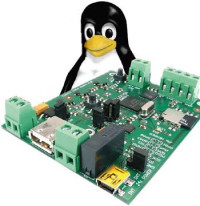Music Pad : 'TuxPad'

The idea would be for musicians, or DJs. With this pad, you could load on your SD Card some sounds and assign each one to a pad, helped by a small screen (or a software on your PC). A bi-color LED is assigned to each pad (one color : ready or playing(when flashing), one color : pad not assigned yet) Pads are some piezzo sensors.
The idea would be for musicians, or DJs. With this pad, you could load on your SD Card some sounds and assign each one to a pad, helped by a small screen (or a software on your PC). A bi-color LED is assigned to each pad (one color : ready or playing(when flashing), one color : pad not assigned yet) Pads are some piezzo sensors. (The sound played depend of the hit) Output : Jack 3.5 stereo (headphone) / XLR symmetric (L, R)
Fun time : Did you ever work in the future ? Thanks to the Linux Board, that's now possible : "make: Warning: File `GPIO.c' has modification time 52 s in the future".
June 20, 2012 : Working on the SPI device through Embedded Linux. I am making a driver for the LTC2602. In the 1st version made, there is too much delay with the CS (550us delay before the 1st SCK rising edge) whereas the CS have to work at 88kHz.
June 28, 2012 : I made functions with direct GPIO registers access ( using mmap() and offsets) and that's really faster. (I've attached a small picture to compare the different methods : Pict 1-GPIO access comparison). I still have a problem with the SPI, the driver appears very slow (Pict 2-SPI delay). Thus I need now to make the driver running faster... any ideas ?
July 3, 2012 : The SPI is still a problem, too much instructions in the driver before/after sending the data. I tried the same idea as the GPIO access but configuration does not work. The last solution, I think, is to rewrite the whole driver to make the SPI access the fastest as possible.
I'll continue this project with the first idea I have, without embedded Linux. I will probably use a PIC32 (with USB host/I2S/...) so please follow this project on the PIC32 Drum Pad project.
| [ibimage==781==ib_thumbnail==none==self==null] | This is a Dead End Project. It is kept for reference and may save you time. If you have a solution the project may be revived. |




Discussion (2 comments)
ClemensValens 11 years ago
MIDI can be done over the UART which is also the Linux console port. Normally, when done booting, you don't need the console anymore. Anoher option would be to implement a soft UART for the MIDI interface.
Regards,
Clemens
ClemensValens 11 years ago
Nice idea.
This would be a nice application for the Elektor Linux Board, but you have to find a solution for the audio output as the I2S ports seem inaccessible. Maybe you can find a stereo DAC with SPI audio interface?
You could use the SD card to store audio samples and maybe USB memory sticks too. If you use the Linux Board also as a USB mass storage device then you can load samples quickly from a PC without fiddling with the SD card. This might need USB OTG or some other scheme.
You should add a MIDI port so you can control the player from a virtual studio or a master keyboard. Connect MIDI to the LPC's UART.
XLR output is probably over the top, I would use two 6,3 mm mono jacks.
Regards,
Clemens
ClemensValens 12 years ago
fx 12 years ago
fx 12 years ago